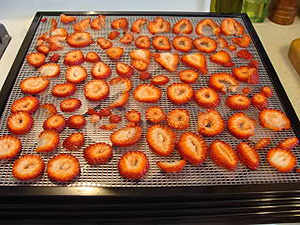Recipes for Jerky
- ¼ cup soy sauce
- 1 tablespoon Worchestershire sauce
- ¼ teaspoon each of pepper and garlic powder
- ½ teaspoon onion powder
- 1 teaspoon hickory smoke-flavored salt
* for 1½ to 2 pounds of lean meat (beef, pork or venison)
Mix everything together. Add your meat and marinate overnight. Put your meat on the dehydrator according to the instructions of your machine. Eight hours later - Jerky!
- 1 cup soy sauce
- ½ cup honey
- 2 teaspoons red pepper flakes
- 1 cup orange juice
- 2 tablespoons liquid smoke
- ¼ cup red wine or cooking sherry (optional)
Cut the beef into very thin strips (partially frozen helps a lot), and marinade overnight. Pat dry and dehydrate!
- 2 lbs lean beef
- 6 cloves garlic, minced
- 3-4 habaneros, minced (I left the seeds in)
- 2 tsp ground allspice
- 2 tsp dried thyme
- 1 tsp dried oregano
- 1 tsp nutmeg
- 1 tsp ground cinnamon
- 5 tsp ground cayenne
- 3 tsp salt
- 1 tsp fresh ground black pepper
- 1 2" piece of fresh ginger, grated
- 1 lime, juiced
- 6 tbs crushed pineapple & juice
- 1 tbs soy sauce
- 1 2" piece of fresh ginger, grated
- 12 ounces (1 standard can) cola (not diet)
- ½ cup Worcestershire sauce
- ½ cup teriyaki sauce
- 2 tablespoons liquid smoke
- 2 tablespoons light brown sugar
- 1 tablespoon garlic powder
- 1 tablespoon onion powder
- Black pepper or hot pepper sauce to taste
Combine all ingredients and mix well. Place meat in freezer zip top bag or covered container. Pour marinade over meat. Marinate overnight for jerky or at least two hours for grilled meats.
For jerky: Drain meat from marinade, discarding marinade. Pat dry. Dehydrate using your favorite method.
Combine all ingredients and mix well. Place meat in freezer zip top bag or covered container. Pour marinade over meat. Marinate overnight for jerky or at least two hours for grilled meats.
- 12 ounces (1 standard can) cola (not diet) ½ cup Worcestershire sauce
- ½ cup teriyaki sauce
- 2 tablespoons liquid smoke
- 2 tablespoons light brown sugar
- 1 tablespoon garlic powder
- 1 tablespoon onion powder
- Black pepper or hot pepper sauce to taste
For jerky: Drain meat from marinade, discarding marinade. Pat dry. Dehydrate using your favorite method.
Recipes for Fruits & Vegetables

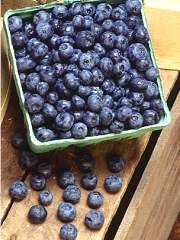
Blueberries are useful in a wide range of finished foodstuffs, and are available to the consumer as fresh, frozen, and dried products. Historically, Blueberries that were dried came from fresh fruit processing, and resulted when the fresh fruit was culled for immature, overripe and off-grade defects. We were drying culls! Today, the demand for dried fruit and the over-production of Blueberries has resulted in the drying of high quality fresh fruit during harvest, and later in the year, as frozen Blueberries that are thawed and then dried, all depending on consumer demand for fresh and frozen products.
Due to the wide variety of uses, and varying specifications for each application, the dried Blueberry exits the dryer at a variety of moisture contents. When used to flavor Ice Cream, and jellies /jams, the target Moisture Content (TMC) can be as much as 50%. Applications like trail mix require the fruit to be in the 15% to 20% range. When used in pancake/muffin mixes where the dried fruit and flour mix are not separated, the TMC must be at 5% to 7% to prevent clumping. To maximize product quality, and minimize loss through dehydration, many processors sugar infuse Blueberries prior to dehydration.
NOTE: In most cases Blueberries are harvested for fresh consumption, allowing for final ripening during freight, distribution, and on the grocery shelf. This affects frozen Blueberries and really affects the fruit that is dehydrated (fully ripe fruit are best suited for dehydration).

For small and medium volume processors, tray drying Blueberries is the most cost effective procedure. We generally recommend a process air temperature of 165°(F), air velocities of at least 500 feet per minute, and Relative Humidity (RH) of 17% to 19%. The most popular methods for tray drying Blueberries include Counter-Flow, and Batch to Dry. Parallel-Flow is problematic with case hardening as the primary issue, and Classic Batch results in uneven product moisture content from car to car.
Pre-dehydration sizing improves fruit consistency and overall quality.
Please remember your Dryer is not a "magic machine"; and just like computers: garbage in = garbage out. High quality dried fruit must start out as high quality fresh fruit, harvested at the peak of ripeness. Yes, we can augment the sugar content, and extend the availability of the fruit by freezing, but ultimately quality begets quality, and quality sells!
One last note: If you dry previously frozen fruit, and then attempt fresh fruit, you will notice that the fresh fruit takes longer in the dryer. The shortened dwell time for the previously frozen product, is due to the slow freezing of the fruit. When cells in the fruit freeze, the cell membranes burst, allowing "free water" to escape at a much faster rate than fresh.
The very last note: Blueberries are dried whole, with the skin intact, however, some progressive operators are now passing the fresh fruit through a set of rollers, set just tight enough to split the skin (not crush the fruit), and thus are achieving significantly reduced dwell times. The fruit must be sized prior to this operation.
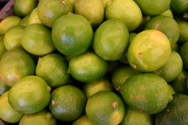
Dehydrated lime is made by drying matured fresh limes by using automatic driers. The color of dehydrated lime varies from yellow to black depending on the drying method. Dehydrated lime is used in cooking and also crushed and mixed with water for a refreshing drink with very high Vitamin C content.
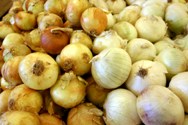
When you first hear the term dehydrated onion, you would probably wonder, who in the world would want to use a dehydrated onion? For one thing, whenever an onion is required in a recipe, what you always do is take a fresh onion and chop away. This is also what your mother did, as well as your grandmother. There is nobody you know who uses dehydrated onions in cooking. Furthermore, you do not even know what a dehydrated onion looks like... or so you think.
Practically everybody has eaten something with dehydrated onion in it—maybe as often as everyday, for some people. Unless you are a vegetarian, I'm sure you have probably eaten a McDonald's hamburger at least once in your life. Tiny pieces of dehydrated onions are in this burger mix that America consumes by the millions each year.
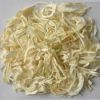
Of course, chances are you have never seen what these dehydrated onions look like outside of the burger. And even if you do know what they look like, you probably would not want to eat it or use it in your cooking. They are not very aesthetically appealing, although they are a quite useful ingredient in many fast foods and instant foods.
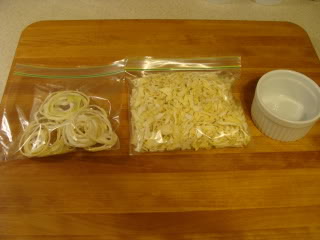
Speaking of instant foods, dehydrated onions are very much in demand by manufacturers of instant soups. Dehydrated soups are very popular among young people today primarily because of their convenience.
All onions for processing are grown from specific varieties best suited for dehydration. Specific strains of the Creole Onion, Southport Globe Onion, and the Hybrid Southport Globe were developed by the dehydration industry. They are white in color and process a higher solid content which yields more flavorful and pungent onion.
Onion dehydration involves the use of a continuous operation, belt conveyor using fairly low temperature hot air from 38-104°C. The heat originally was generated from steam coils, but now natural gas is more popular. Typical processing plants will handle 4500 kg of raw product per hour (single line), reducing the moisture from around 83% to 4% (680-820 kg finished product). These plants produce 2.25 million kg of dry product per year using from 35-46 MJ/dry kg produced (+14 MJ/kg of electrical energy), or 9.3 MJ/kg of water evaporated.
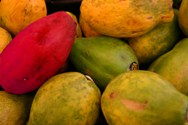
Papaya is becoming increasingly a popular fruit on world markets.
Papaya is full of Vitamin A and makes an unusual fruity alternative to apricots and apples. Dehydrate your papaya for a healthy treat you can take along anywhere.
Papaya dehydrates at a ratio of 12 to one. That means 12-pounds of fresh ripe papaya will yield 1-pound of dehydrated product. This product, when packed in a nitrogen atmosphere, will keep for five years. It can be ground to a powder and sold to food processors world wide, as an ingredient in juice drinks, for example.
History: The commercial dehydration of Prunes has evolved from the early days at turn of the twentieth century; when drying small amounts of fruit on wooden trays, laid out in the sun was common. Today?s modern high tech and high volume systems are a far cry from those humble beginnings. The first attempts at building a commercial Prune dryer (not requiring a sunny day), centered on the ?Natural Draft? dryer. This design required a small fire be built at the bottom of an inclined shaft, and trays loaded with fresh fruit were placed in the flue where the hot gases and smoke passed up through the trays. The natural tendency of the warm air to rise provided the air velocity, and the heat from the fire raised the core temperature of the fruit, which helped to accelerate the drying process. Even at this early date, the operators knew enough to move the trays ever closer to the fire as the product dried, to prevent case hardening. From 1910-1920 this was the ?state of the art? in dehydration technology.
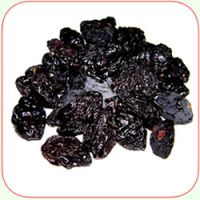
Prunes: Early on, we referred to the fruit on the tree as Plums, and when it was dried, we called this wrinkled, oversized raisin a Prune. Today there are many varieties; from baseball sized fruit to the tiny ?Breakfast fruit,? all requiring dehydration to stabilize the fruit that will suffer degradation within hours of picking. Dehydration allows for the ambient air storage of Prunes for months if not years.
Prunes are dried whole, normally with a quick water rinse, to remove dust and rudimentary debris removal helps keep the dried product at high standards. The skin of the fruit is remains intact, and the pit remains inside the fruit. While most processors dry the fruit without sizing (field run), there is a move to pre-size the fruit into two or more sizes, and dry each size separately, thus improving the quality and uniformity of the dried product, while cutting the time and expense in the operator. This effort insures the small fruit are not over dried and lost, while the large fruit are dried to standard and without re-drying or equilibration (mixing the dried fruit so as to achieve desired moisture content), makes pre-sizing very desirable.
Tray drying is the norm for commercial and industrial level processors, but drying on continuous flow belt dryers will slowly replace the tray dryers in the future due to the high labor costs and the continuing costs of wood trays.
When tray drying prunes, there are two procedures currently in use; Counter-Flow and Parallel-Flow (see definitions) for large production applications. The only known application of Parallel-Flow dehydration is in the California Prune Industry. While Parallel-Flow is acknowledged to be faster, it engenders quality issues that have limited the viability of the fruit and customer satisfaction of the end product. The Counter-Flow method takes more time in the dryer, but generally turns out a product that is less affected by case hardening, is dry uniformly from pit to skin, and is softer to the touch. For smaller volume applications, Prunes can be dried in Batch, Batch to Dry, and Batch Rotation methods.
In all but the Parallel-Flow method, the process air temperature should be 165°F, with a Relative Humidity (RH) measured at the hot end at about 17% to 19%. Fruit on the trays should be 1 to 1½ fruit deep on standard wooden trays. The fruit needs to be placed on the tray uniformly. Dwell times vary based on fruit size and sugar content, but will generally range from 20-24 hours. The fruit is removed only when it is at the correct moisture content. In the Parallel-Flow process air temperatures (PAT) run from 185-190 °F, and dwell times are mandated by a time schedule required due to the fruit?s propensity to case harden. Pulling the fruit to a schedule, not when it is at the correct moisture content, requires the re-dry and equilibration procedures.

Raisin dehydration in heated air dryers was first devised in the early part of the twentieth century as a means of salvaging rain-damaged raisins. It was also used for a short period to preserve wine grapes during the Prohibition era after ratification of the Eighteenth Amendment. In 1925 the light colored golden bleached raisin was developed, and it required dehydration. Annual production of this new product was about 25,000 tons until World War II. During the war, dehydration was used extensively to ensure a stable supply of product. Many of the earliest dehydrators had no fans and used natural draft to slowly move air past fruit placed on a slotted floor or through fruit placed on trays. In the early 1920s commercial dehydrator firms began marketing a number of types of forced-air dehydrators and these quickly became the industry standard. The main differences between the designs were the location of the air re circulation duct, the type of heating system, and the type of fan, but they operated in the same general fashion as the truck-in-tunnel dehydrators now in use.
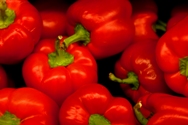
Bell peppers will re-hydrate to double in size in cool water. They can be used in any recipe where raw peppers are required. Drained, they can be sauteed, added to fresh salsa, or salads (although the size of the dices may be too small for a green salad). They do not have the crispness associated with fresh but flavor is there.
Cooked into casseroles, soups, meatloaf, or other main dishes, you will find they are identical to cooked fresh peppers.

Food Dehydration is the oldest form of food preservation. In the beginning, people used a lot of salt to preserve foods, and they dried their food in the sun or on stove tops.
Strawberries are one of the world?s most popular berries. They are most available April through July, but can be enjoyed year round by preserving them. Unlike frozen strawberries, dried strawberries can be stored at room temperature and do not rely on electricity to maintain their quality.
